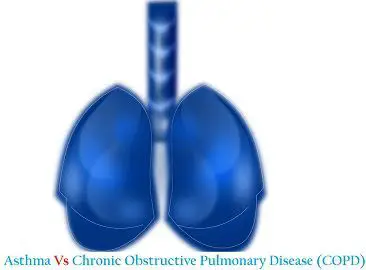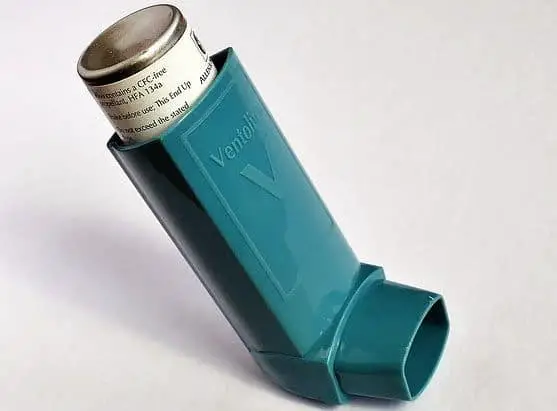The respiratory disease which is diagnosed during childhood, resulting in shortness of breathing, dryness of a cough, chest tightening is called asthma. On the other hand, COPD also known as Chronic Obstructive Pulmonary Disease is also one of the respiratory disease, which occurs after the age of 4o, and the condition gets progressively worse with age.
The cell’s of our body need oxygen to work and grow, and this oxygen is taken by the lungs through the simple process of breathing. Usually, in a day, we breathe 25,000 times a day. But people suffering from any lungs infection experience the problem in breathing.
Lung diseases are one of the most common medical conditions existing in the world. There are many kinds of lungs infections like bronchitis, cystic fibrosis, emphysema, COPD, asthma, pneumonia, tuberculosis, etc. pollutions, infections, allergens, smoking or genetics can be the major cause of all these problems.
In this article, we will mark the vital difference between the two common respiratory disease – asthma and the COPD. We will also discuss their causes, symptoms, and treatment.
Content: Asthma Vs Chronic Obstructive Pulmonary Disease (COPD)
Comparison Chart
| Basis for Comparison | Asthma | Chronic Obstructive Pulmonary Disease (COPD) |
|---|---|---|
| Meaning | The long term medical condition of the respiratory tract, which is manageable with the proper treatment by recognising the primary cause of the disease, and avoiding them with full precaution. | The kind of respiratory disease which is diagnosed in the later stage of life and the condition of the patients get severe with the onset of disease. Smoking is said to be the cause of this disease. |
| Age of onset | Usually in childhood, but have onset again at any stage. | Usually, occurs at the age of 40+. |
| Symptoms | 1.Wheezing. 2.Shortness of breath. 3.Trouble sleeping. 4. Congestion, runny nose, cold, allergies. | 1.Chest tightness, pain. 2.Coughing. |
| Kind of obstruction | More intermittent airflow obstruction. | Progressively worsening airflow obstruction. |
| Cough | Dryness of a cough. | A nocturnal cough or on exertion. |
| A cough is more mucus yielding. | A morning cough with sputum. | |
| Smoking history | May be non-, ex- or current smoker. | Usually>10 pack-years. |
| Causes | Genetic or environmental factors. | Usually smoking related, but also linked to environmental and genetics. |
| Airway inflammation | Eosinophilic | Neutrophilic. |
| Diagnose | 1.X-ray or sinuses. 2.Family history is checked. 3.Spirometry and CT scan. 4.Physical exam. 5.Peak airflow. | 1.Spirometry. 2.X-ray. 3.CT scan. 4.Blood test. |
| Treatment | Corticosteroids to reduce inflammation, bronchodilators, oral steroids. | Permanent pulmonary rehabilitation, airway opening medications, oxygen support in severe stage. |
| Prevention | Avoid coming in contact with the allergens, air pollution. | Avoid smoking and coming in contact with polluted air. |
Definition of Asthma
Asthma is a kind of respiratory disease, which occurs due to the inflammation of the bronchial tubes. Along with the increased production of the sticky secretions inside the tubes. The person suffering from this disease experiences with an tighten, inflame, or mucus filled airways.
Asthma is often diagnosed during childhood, though the exact cause of asthma is still unknown it is believed that it is caused due to environmental factors or can be genetic.
But not every person with asthma has the same symptoms at the same time; it may vary from the mild one to the severe attack. These periodic worsening of the symptoms causing swelling, tightening, difficulty in breathing and mucus causes the asthma attack. These can be reversible and come and go.
The severity of the asthma attacks vary. Usually, mild asthmatic attacks are seen than the severe attacks. In mild asthma attacks the airways open for some time only but in the case of severe attacks, the effects are long lasting and requires immediate medical treatment. The condition of asthma may get worse when they get exposed to cold air, exercise, and allergens.
The standard treatments include:
1.long-term medications for controlling asthma like corticosteroids, inhalers, and theophylline.
2.allergy medications (immunotherapy).
3.bronchial thermoplastic.
4.quick-relief medications (bronchodilators).
Definition of Chronic Obstructive Pulmonary Disease (COPD)
This disease is diagnosed at the later stage of life, which is after the age of 40. COPD refers to the two types of lung infections – emphysema and bronchitis and often occur together. In this disease, the airways or the tubes which carry air in and out of the lungs get partially blocked and results in the problem in breathing.
Normally the tiny air sacs which are present at the end of the airways, inflate or deflate during the breathing process. But with COPD, these tiny air sacs become less flexible, and the problem arises in breathing.
Emphysema plays the major role in causing a destruction of the air sacs and thus creating the problem in the outward flow of air. While bronchitis causes the narrowing of the bronchial tubes, due to inflammation and resulting in the formation of mucus.
The condition of the patient gets progressively severe, as in the beginning, the symptoms may be mild with shortness of breath and coughing. But in later stage the difficulty increases with increasing problem of breathing, chest tightening, wheezing,
Smoking is the cause of this disease, whether the patient has smoked in the past, exposed to secondhand smoke, lung irritants, or suffered from asthma, air pollution, dust, or chemical fumes. Although there is no cure. Treatments like oxygen therapy, medicines, the lung transplant may provide relief. Most important step for the treatment is to quit smoking.
Key Differences Between Asthma and COPD
The following points will target on the fundamental differences between both kinds of reparatory diseases:
- The long term medical condition of the respiratory tract, diagnosed in childhood but is manageable through the proper treatment by recognizing the main cause of the disease, and by taking proper precautions is termed as asthma. While the COPD or Chronic Obstructive Pulmonary Disease is the another kind of disease, diagnosed in the later stage of life which is usually after the age of 40 and the severity of the illness goes on increasing with the time.
- Symptoms of the asthma are wheezing, shortness of breathing and dryness in a cough, which arise on exertion, while the symptoms of COPD include wheezing, a problem in breathing and cough is more mucus yielding with sputum especially in the morning
- The cause of asthma can be genetic, environmental factors, allergens, etc. But in a case of COPD, the main cause is the continuous smoking for more than ten years by the patient or sometimes can be due to genetic or environmental factors also.
- More intermittent or periodic airflow obstruction and eosinophilic airway inflammation are observed in asthma, whereas progressively worsening airflow obstruction and neutrophilic airway inflammation is observed in COPD.
- Asthma is diagnosed through many ways like by knowing the family history, or by X-ray or sinuses, Spirometry and CT scan, Physical exam or Peak air flow test are done. COPD is diagnosed through the Spirometry, X-ray or by CT Scan.
- Treatment of asthma can be done by using bronchodilators, oral steroids and corticosteroids to reduce inflammation, whereas permanent pulmonary rehabilitation, airway opening medications, oxygen support in a severe stage are the treatment given to the patient suffering from COPD.
- Asthma occurs due to genetic problems, allergens, and air pollution. Therefore the patient should avoid coming into contact with the allergens, air pollutions as the episodes of the asthma attack can arise anywhere. By following certain measurements, it can be controlled in getting severe from the mild. In the case of COPD, the person should most importantly avoid smoking and come in contact with polluted air.
Similarities
- Both are the respiratory disease.
- They are characterized by obstruction to the airway.
- Both need the physical exam for diagnosis.
- Both require air filter for prevention.
- They both are preventable through different methods.
Conclusion
From the above article, we conclude that both are the kind of respiratory disease and affect the health severely, which can be life threatening too. Hence, if the person diagnosed with any such infections, he/she must follow the proper medication, treatments, and other precautions.
The person should not mistake their abnormal breathing and other symptoms as normal and must visit the health care professional.




Leave a Reply